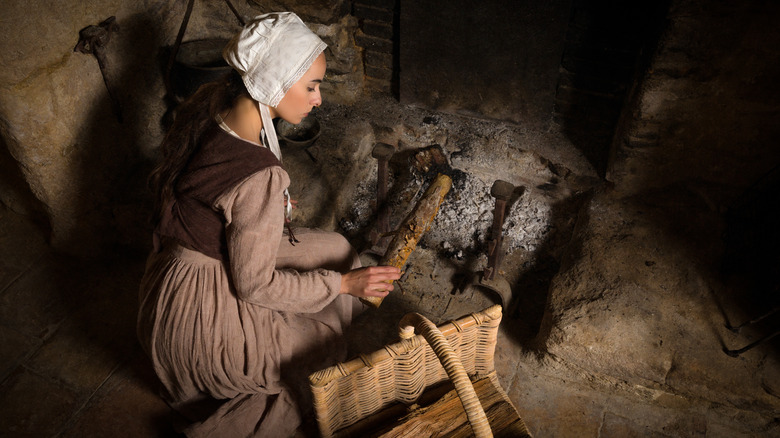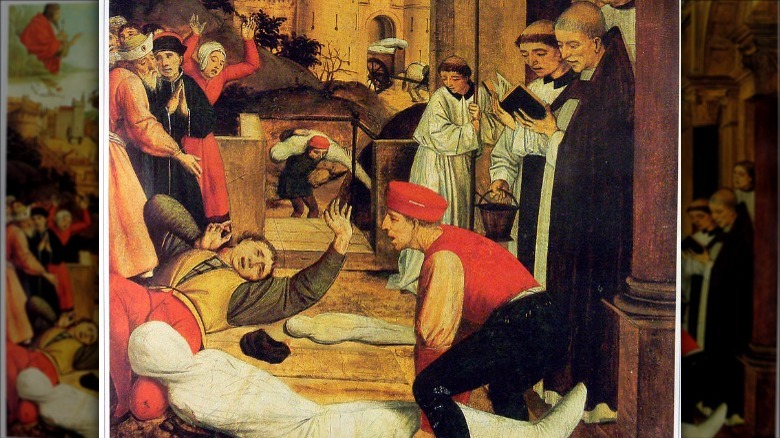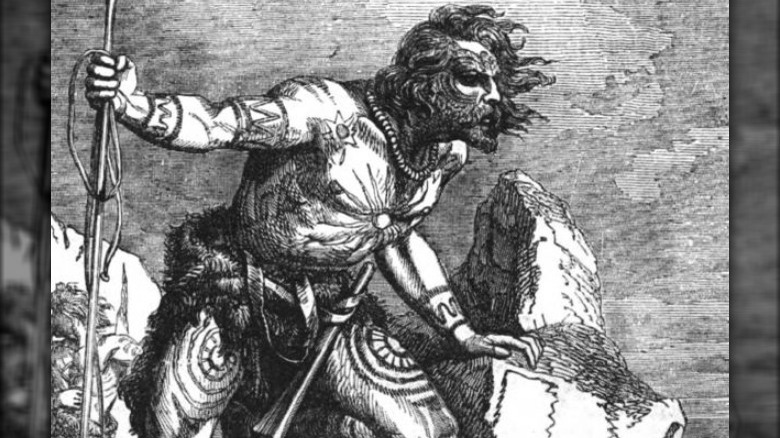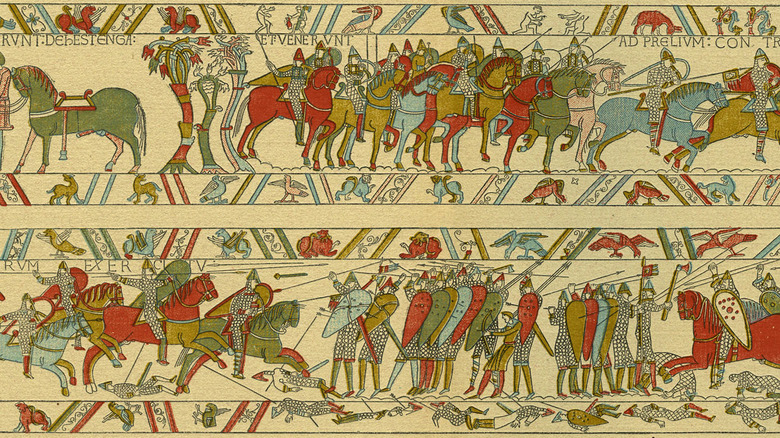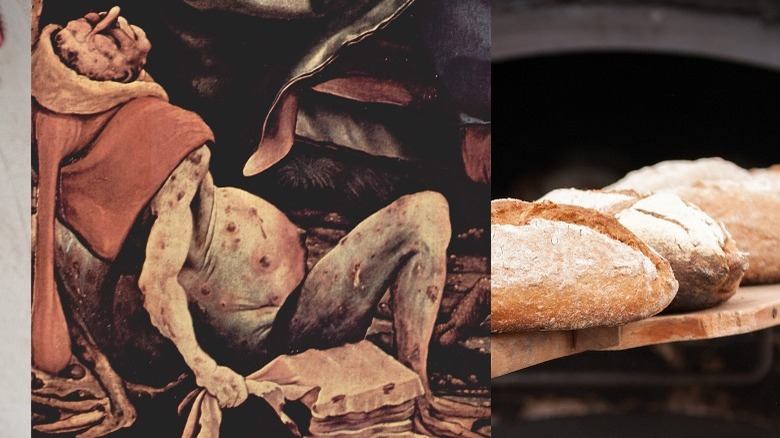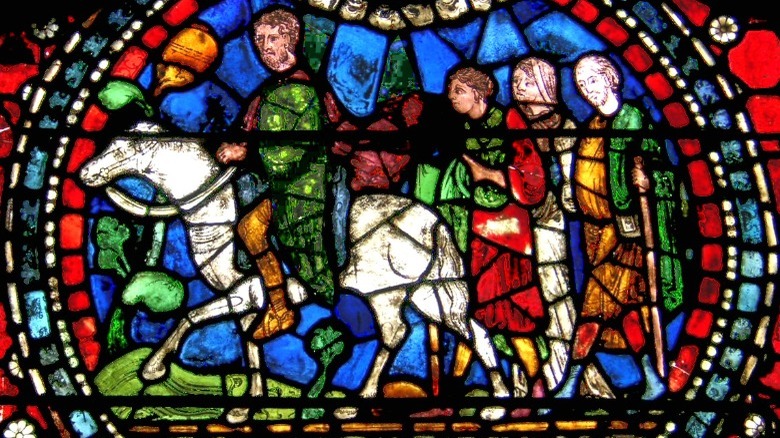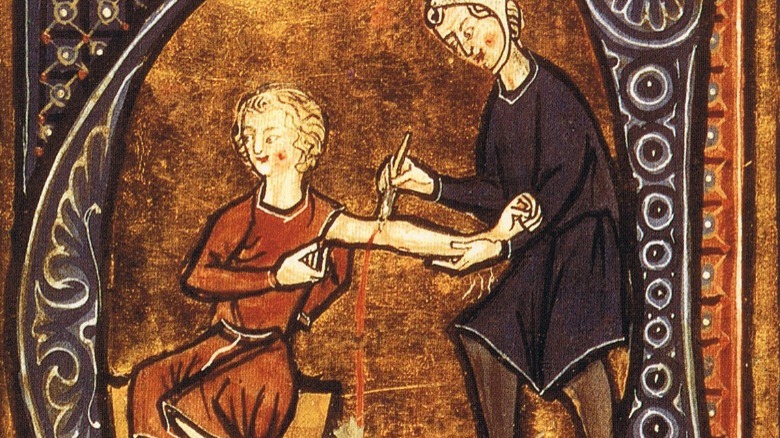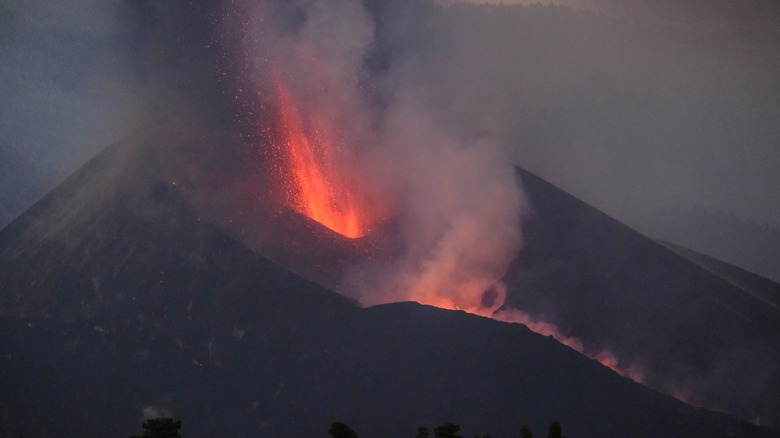Why You'd Never Survive Life During The Dark Ages
Firstly, let's clear something up: The term "Dark Ages" is a bit of a misnomer. While these centuries were definitely difficult and deadly, they weren't quite the period of stagnation that the name implies. That, says History, came thanks to Renaissance scholars who were wildly dismissive of all that had happened in the period after the fall of the Roman empire up until, well, themselves.
The so-called Dark Ages were a time when humankind was really sort of getting itself sorted out ... for better or worse. The Church was increasing in power, there were huge advances in agriculture, math, and science, and there were powerful, world-changing dynasties in place, like Charlemagne and the Carolingians.
There are no real, set-in-stone dates that define the Dark Ages, or — as ThoughtCo. points out — that even define the Middle Ages. For the sake of argument, let's define our "Dark Ages" as the time between the fall of Rome in the late 5th century and what's generally thought of as the High Middle Ages. (That's the 11th century ... mostly.) And now, let's find out that no matter how tempting it might be to want to live back in an era of simpler times, modern people just aren't cut out for surviving there.
Justinian's Plague lasted for centuries
The Black Death might conjure up images of plague doctors and 17th century Europe, but according to National Geographic, the later outbreaks of the bubonic plague were actually linked to one that kicked off in the 6th century. It was called Justinian's Plague, after Justinian I: He was emperor when death and disease came to Constantinople in 542. According to World History, entire generations were born and died in a world tainted with plague, as it didn't end until almost 200 years later, in 750.
The plague spread like wildfire for the perfect storm of reasons, including an unusually cold spell that meant food was scarce and people were leaving their homes to seek their fortunes — and survival — elsewhere. Trade was booming, and plague-infested fleas hitched rides on rats that, in turn, hitched their rides on the boats and carts of trade caravans. By the time it disappeared, it had devastated the population of the known world. The death toll is uncertain, but it's estimated that about half the population died — somewhere between 30 and 50 million people.
Symptoms are familiar to anyone who's read about the Black Death, and there's a good reason for that. In 2014, a team of researchers discovered that the strains of bacteria that caused the devastating outbreak weren't just equally deadly, but they were related. The bacteria can be killed with antibiotics, which our Dark Age ancestors didn't have.
Violence filled the void the Romans left
There's a saying that Rome wasn't built in a day, and it didn't fall in a day, either. As the once-mighty empire began to crumble, people who had lived under the protection of Rome for centuries were suddenly left to figure things out for themselves. Things were pretty dire in 410 thanks to a combination of internal strife and attacks from outside forces like the Goths, the Saxons, and the Picts. Now, add in usurpers ready and waiting to take advantage of the weakened empire: Even in instances where citizens ousted pretenders — like Constantine III — the BBC says that their appeals to Rome for help against advancing tribes were unanswered.
Let's look at Britain. A group of Saxon mercenaries was initially hired to protect against advancing Picts, and then, those Saxons decided they'd had enough of the mercenary life, and this was a perfectly nice land to settle down in, we'll take it all, thank you very much. The takeover was described as "blood and thunder," and here's where things get confusing.
The archaeological record is a little iffy when it comes to looking at just how much bloodshed there was. Destruction might not have happened on an epic scale, but there was plenty of fighting, small-scale squabbles, and, of course, all those barbarian hordes. They were anything but primitive, says History, using advanced weapons and armor — like chainmail and chariots — to carve themselves a piece out of Rome's already-bloody carcass.
William the Conqueror's relentless onward march was genocide
William the Conqueror's invasion of the British Isles came at the end of the Dark Ages, and it was a pretty terrible way to wrap up what had been a terrible few centuries. William was more properly called the Duke of Normandy, and at the time his rule was getting up and running, it's believed the English king (and his cousin, notes History) Edward the Confessor had promised to name him as heir to England ... but didn't.
That kicked off the Norman invasion, and it was dire stuff. William didn't seem too concerned with the fact that if he killed everyone, he wouldn't have much of a kingdom to rule — and he set about trying to kill everyone, particularly where resistance was the greatest: the North.
Places like York continued to resist, and in 1069, northern rebels slaughtered the army he dispatched. According to History Today, what followed was called the Harrying of the North. William decided to destroy the area's resources, and ended up doing just that so completely that when famine set in, it was so bad that reports of cannibalism were commonplace. One historian — Symeon of Durham — wrote that there was simply no one left in most of the country's small villages, and it would be nine years before people started moving back. The Domesday Book of 1086 described about a third of the area as an uninhabitable wasteland.
The bread could easily kill you
During the Dark and Middle Ages, any bite of bread could be deadly. National Geographic says that for centuries, Europe was the site of a devastating plague that became known as St. Anthony's fire. It was named for the monks of St. Anthony of Egypt, an order that was founded in 1093 primarily to care for the afflicted — and it was awful stuff. The feeling of burning in the extremities would escalate into hallucinations and seizures, and as the disease progressed, limbs would turn necrotic and fall off at the joints.
This wasn't just a few people at a time, either. In 994, an outbreak in France left 40,000 dead. The historian Mezeray wrote (via Lapham's Quarterly): "The cries of those in pain and the shedding of burned-up limbs alike excited pity; the stench of rotten flesh was unbearable."
And that was just one instance. It was so widespread that 370 hospitals were eventually built by the monks of St. Anthony, and outbreaks would continue to happen. It wasn't until centuries later that scientists figured out what caused it: the fungus called ergot. It acts by producing a compound that interrupts the blood supply to the limbs, and as it impacts cows as well as people, a bit of tainted grain could destroy entire communities.
The Catholic Church probably didn't like you
The Catholic Church was — in the grand scheme of things — really just figuring out what it was all about in the Dark and Middle Ages. The 7th century, for example, saw the development of the Rule of St. Benedict, which were guidelines for those living in religious communities. And according to The British Library, the church was pretty hardcore right from the beginning when it came to people disagreeing. Any Christians who weren't on board with any elements of the church's teachings were likely to find themselves on the receiving end of a good flogging or even execution.
World History says that pre-Dark Ages, there were a variety of different ways that the Christian faith was interpreted. The first Council of Nicaea in 325 was called to unify things, but that didn't stop people from believing things like the radical idea that only clergy members who are themselves free of sin should give rites and lead mass. After the Council determined what was right, the church went after heretics hardcore.
Take The Paulicians. They were established by Constantine-Silvanus in the 7th century, and believed no priest was needed to commune with God. He was stoned to death in 684, while his followers were burned at the stake. Those that survived founded the Bogomils, and they were the target of some severely bloody Crusades. Thinking you were going to decide what you wanted your faith to be could be deadly.
It was a terrible time to be Jewish
The United States Holocaust Memorial Museum says it's difficult to know just how extensive antisemitism was during the Dark and Middle Ages, but there are some records that suggest it wasn't a great time to be Jewish — particularly once Gregory I became pope in 590. Gregory I, says Britannica, used economic policies to strong-arm Europe's Jewish population into converting to Christianity, and, after his papacy ended in 604, events took a turn for the worse.
That's when the church got together with monarchies — particularly in Spain and France — to expel Jewish residents. Others were given the choice between converting to Christianity, or becoming a slave. Anything that happened to those who chose slavery was viewed as just being a bit of divine justice, delivered by God for not coming around to the right way of doing things.
Historians — like Dr. Julius Furst — have pinpointed groups of Jews who were specifically targeted (via the Jewish-American History Documentation Foundation), and that included those who lived under some of the groups that moved in when the Romans left. Beginning in 586, the Visigoths of Spain enacted severe laws against Jews, and the punishment for breaking those laws (which included things like celebrating Passover or observing the Sabbath) was death via stoning or being burned at the stake. By the time another king took over in 612, that escalated: Any Jew found in the country would be "punished with a hundred blows," then exiled and stripped of their property.
Pilgrimages were wildly dangerous
The idea of the pilgrimages was to visit a sacred place, and ideally get a little closer to God in the process. According to The Met Museum, the practice was widely popular as early as the 4th century, and throughout the Dark and Middle Ages, Europe's faithful were encouraged to undertake the journey to places as far away as Bethlehem and Jerusalem.
It was incredibly dangerous, and while LiveScience says that the formation of the Knights Templar was done in order to protect pilgrims on their way to the holy land, that only happened around 1118/9. Before that, people were on their own.
Just imagine all the ways there were to die on a pilgrimage. Historians Adrian R. Bell and Richard S. Dale say (via OUPblog) that most pilgrimages would take a year or more, and on the way, pilgrims would face things like running into criminals of all sorts around every corner. There was also the possibility of things like shipwrecks and being caught in natural disasters, and how about some disease thrown in for good measure? According to World History, about two centuries' worth of pilgrims would have been traipsing through plague-infested cities and villages. And getting there was, of course, just half the battle — the return trip came with just as much deadly potential.
Lead was everywhere
Indoor plumbing is actually nothing new. The Romans had it on a massive scale, and according to ArsTechnica, some of the indoor water features of the rich and powerful would make any 21st-century person jealous. Research has found that the prevalence of lead pipes increased in the 1st and 2nd centuries, and there's a theory lead poisoning ultimately damaged Roman people so extensively that it helped speed up the fall of the empire. That's debated, but what's not debated is that lead continued to be a huge problem — particularly for the rich.
It's easy to think that those who happened to be born into the upper class had a better time of it — and a higher chance of survival — than the poor sods at the bottom, but a fascinating study from the University of Southern Denmark (via EurekAlert!) has shown that the rich had their own ways of shortening their lives. When they excavated 207 medieval burial sites from across Denmark and Germany then examined skeletons for lead, they found that upper-class remains contained high levels of the toxic substance.
In those cases, the culprits were things like lead-based pottery glazes (which were only available to the wealthy), and drinking water collected from rooftops and gutters. But there's another source, too, says the Smithsonian, and it goes back to Rome. They sweetened things like wine with something called "sugar of lead," and that wasn't a figure of speech. It was lead acetate, and it was deadly.
Infants died in a shocking number of ways
The sad truth of the Dark Ages is that only a small fraction of babies born would even make it to an age where they needed to worry about things like dying slowly from lead poisoning or dying quickly while fighting hordes of barbarians. Nicholas Orme of the University of Exeter says that 1 in 4 babies would die before they reached their first birthday, and they weren't out of the woods yet. Children between one and four had about a 12.5% chance of dying.
Let's put this in perspective. According to Thomas Izbicki of Rutgers University (via Medievalists), it presented a huge problem for the church. Babies who died before they were baptized weren't going to be welcomed into heaven, and when death came, there wasn't always a priest around who could get there first.
Leo the Great was pope in the late 5th century, and he issued a declaration that as long as the ceremony was performed properly, anyone could do it (with the exception of those who were deemed heretics). They were called emergency baptisms, and here's the really telling thing: It was perfectly acceptable to have the ritual performed by a woman, a pagan, or even a Jew. Local clergy were instructed to make sure members of their congregation — and of the community outside that congregation — could properly baptize an infant, because fears of sudden damnation were powerful motivators.
One word: Vikings
No discussion about the dangers of the Dark Ages would be complete without mentioning the Vikings, but here's the thing: There's a massive schism between schools of thought when it comes to figuring out just how bloodthirsty they were.
According to the BBC, the Vikings raided and sacked the monastery at Lindisfarne on June 8, 793. For the next 300 years, they would sail and pillage from Newfoundland to France to what's now Ukraine, and there are some chilling stories of their ferocity. But ... are they just stories? Maybe, and maybe not. Independent journalist Patrick Cockburn goes as far as saying that they committed "atrocities ... the equivalent of those carried out by SS divisions invading Poland," while others — like Yale history professor Anders Winroth — say (via National Geographic) that all the bloodshed is a massive exaggeration.
While scholars are still arguing that point, one thing that's for sure is that there were shockingly bloody incidents where people just didn't walk away. On November 13, 1002, Aethelred the Unready ordered everyone in his English kingdom to go kill any Danish men they could. The goal was to get everyone, and while it's uncertain just how many people were slaughtered during the St. Brice's Day Massacre, the Archaeological Institute of America confirms that mass burial sites connected to the declaration have been uncovered and excavated.
One of the most common medical treatments was deadly
Bloodletting had been around for a long time by the time the Dark Ages rolled around, and for as disturbing as this is going to get, let's start out by stressing it's not a Dark Ages invention. History says that bloodletting started in ancient Egypt and spread to ancient Greece, so by the time physicians in the medieval era were doing it, it had a fairly respectable history.
In the Dark Ages, though, people maybe got a little carried away. It was used in the treatment of a shockingly wide array of illnesses, from epilepsy and gout to the plague. Special tools were used to puncture arteries, and if that sounds incredibly dangerous, it is: Duke Today says that it definitely killed more people than it cured.
Healthline says that most of the time, the amount of blood was measured by how long it took for the patient to pass out — that's when they generally stopped. Death happened for a number of reasons, as not only was hemorrhagic shock and death from blood loss a very real possibility, but infections were common. At a time before antibiotics, this was a death sentence.
The worst years to be alive
It's no secret that the decade that started with 2020 got off to a terrible start, and then just sort of spiraled out of control like a worldwide episode of Jackass. But here's the thing: the Smithsonian says that scores of research have found that there was an even worse time to be alive.
In addition to their very own Justinian Plague, there were also a series of volcanic eruptions that started in 536. The first was so huge that it filled the earth's atmosphere with all kinds of dust, sulfur, ash, and debris that it blocked out the sun for a whopping 18 months, and that was just the first. The result was a global drop in temperatures, and History says that led to widespread crop failure and famine. Layer the plague on top of that, and, well, let's let a Byzantine historian named Procopius explain: "Men were free neither from war nor pestilence nor any other thing leading to death."
Strangely, Harvard University professor Michael McCormick says that even though we always had these writings, it was believed they were exaggerated. It wasn't until the 1990s that data from tree rings started to confirm that the stories were absolutely true, and the world had been plunged — literally overnight — into what's now called the Late Antique Little Ice Age. McCormick sums it up like this: "It was the beginning of one of the worst periods to be alive."
